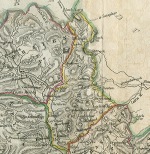The Parish of Dalry.
Placenames
The placenames index for this parish is accessed via the menu on the left. Links from there open up access to various historical and modern maps indicating where the place is to be found as well as links to other historical information and photographs if we have them.
References
Extensive historical information, particularly in the form of scanned books, is becoming available on the Internet.
In this section we have begun listing links to this information relative to this parish.
Old Postcards
Thanks to a Victorian hobby of collection topographical postcards many old views from within the parish are available today. This section contains an ever growing
selection from those we have available.
A TOPOGRAPHICAL DICTIONARY OF SCOTLAND, by Samuel Lewis. Published in 2 vols, London, 1846.
"DALRY, a parish, in the stewartry of Kirkcudbright, 15 miles (N. N. W.) from Castle-Douglas ; containing 1215 inhabitants, of whom 574 are in the village of St. John's Clachan. This parish, of which the name, signifying the " Royal Dale," is derived from a level and fertile plain called the Holm, is about fifteen miles in length, and seven miles in breadth, comprising 33,000 acres. The surface is diversified with hills, of which some are green to their summit, and others are covered with barren heath ; the proportion of arable land is very small, nearly four-fifths of the area being pasture.
The river Ken, which rises in the northern extremity of the parish, forms the western boundary between it and Kells, and, after a beautifully-winding course, flows through Loch Ken into the river Dee. The smaller streams are, the Blackwater, the Earlston, and the Stronriggan, which run through the parish into the Ken ; they all abound with trout, and in the Ken are found also pike and salmon. The chief lakes are, Lochinvar, Boston, Knocksting, and Knockman, of which Lochiavar, about fifty acres in extent, is the most important ; the others are all of very small dimensions, and undistinguished by any features requiring notice. In Lochinvar are the remains of the ancient castle of the Gordons, knights of Lochinvar, and afterwards viscounts Kenmure ; and near it is a cairn, raised as a trophy on a spot where the first knight killed a wild boar that infested this part of the country. The scenery along the banks of the Ken is enriched with ancient woods of considerable extent, of which the largest is that of Earlston, formerly a hunting-seat of the Earl of Bothwell, and in which are some plantations of stately fir.
The SOIL on the Holm lands is tolerably fertile, yielding favourable crops of barley, oats, turnips, potatoes, and rye ; and the hills and higher lands afford excellent pasture. The system of agriculture is improved ; and the surface has been drained, and inclosed with stone dykes of sufficient height to afford shelter to the cattle. Great numbers of sheep and black-cattle are reared in the pastures. In the village is a post-office under that of Castle-Douglas ; and facility of communication is maintained by good roads, of which those from Kirkcudbright to Ayr and Glasgow, and from Newton Stewart to Dumfries and Edinburgh, intersect the parish. The rateable annual value of Dairy is £5/68.
The ECCLESIASTICAL affairs are under the superintendence of the presbytery of Kirkcudbright and synod of Galloway. The minister's stipend is £217. 12., with a manse, and a glebe valued at £20 per annum ; patron, William Forbes, Esq., of Callendar. The church, erected in 1832, is a neat structure containing 700 sittings : in the churchyard is an aisle of the old church, quite detached from the present building, and which is the burying-place of the Gordon family. There is a place of worship for members of the United Secession. Two parochial schools, of which the masters have salaries of £25 each, with a house and garden, in addition to the fees, are supported by the heritors, and attended by more than forty children. A grammar school was founded by Dr. Robert Johnson, of London, who endowed it with £1000 for the gratuitous instruction of the children of the parish ; it is under the management of two masters, who have salaries of £15 each, and is attended by nearly 120 children. The building, erected in 1658, comprises a good dwelling-house and schoolroom, with eight acres of land attached to it. There are several remains of ancient buildings on the farms of Benbreck and Manquhill, supposed to have been the ancient residence of the Galloway family ; and in various parts of the parish, are numerous intrenchments for the security of cattle during the times of the border warfare."
